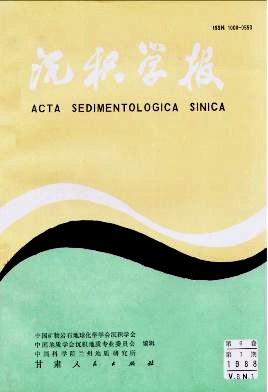Zhang Jinliang, Sou Jianfeng, Yuan Zhengwen, Zhao Chenglin. STORM DEPOSITS IN THE SHASAN MEMBER, OLIGOCENE, DONGPU DEPRESSION[J]. Acta Sedimentologica Sinica, 1988, 6(1): 50-57.
| Citation:
|
Zhang Jinliang, Sou Jianfeng, Yuan Zhengwen, Zhao Chenglin. STORM DEPOSITS IN THE SHASAN MEMBER, OLIGOCENE, DONGPU DEPRESSION[J]. Acta Sedimentologica Sinica, 1988, 6(1): 50-57.
|
STORM DEPOSITS IN THE SHASAN MEMBER, OLIGOCENE, DONGPU DEPRESSION
- Received Date: 1986-02-01
- Publish Date:
1988-03-10
-
Abstract
Storm deposits are well-developed in the Shasan Member of Oligocene in Dongpu Depression. The lacustrine tempestites have many sedimentary features. (1) Pene-contemporaneous deformation structures are well-developed including load structures, ball-and-pillow structures, flame structures, clastic dykes, concolute beddings, etc, The formation of these structures is related to sediment liquefaction and drai- nage, reflecting the characteristics of gravity flows. (2) Scour-and fill structures are conspicuous and they can be divided into two types, sand-filled scours and themud-filled ones cut into sands. The erossional structures, especially the mud-filled scours, seem to be uncommon in turbidite facies. They are the evidence of storm activity. (3) Sandstone tops of Bouma-like sequeces often disply oscillatory ripples. Parting lineations are often found in the parallel lamination sandstones. (4) Hummocky crosss-tratifications are characterized by gently curved, lowangle cross-lamination. Most researchers have specifically inferred their origin results from powerful oscillatory dominant or multidirectional flows. Despite uncertainty regarding the dynamics of formation, hummocky cross-stratification is now regarded as the best indicator of a storm influence in ancient sedimentary sequences. The absence of tidal currents in the lake greatly enhanced the potential for preservation of hummocfcy cross-stratification. (5) Biogenetic sedimentary structures are distinct. Storm activity may have mixed oxygen-rich surface water with stagnant basin water so as to provide more favorable conditions for development of benthic communities. After the storm is over, the sediment surface is then populated by burrowing infauna. The presence of escape burrows reflects a quick depositional event. The sedimentary sequences of the storm sand layers can be compared with Bouma Sequence, but they display more variable sand-stone tops. There are five principal types: (a) sandstone tops modified by subsequent organic reworking; (b) wave-rippled sand-stone tops; (c) sandstone tops displaying mud-filled scours; (d)sandstone tops displaying starved ripples; and (e) sharp sandstone tops. The storm layers vary between proximal and distal types: (a) channel-filled deposits, consisting of massive sandstones; (b) interchannel deposits with complete Sb-Se sequeccesf and (c) distal deposits, mainly consisting of thin silt beds with Sc-e, Sde. Based on single-well microfacies analysis and comparison of well-to-well correlations as well as their paleostructures, paleoclimaes, sources and nature of sand layers, a facies model is presented.
-
References
|
[1]
|
沉积构造与环境解释编著组,l984,沉积构造与环境解释,科学出版社。 |
|
[2]
|
Aigner T.,1982, Cyclic and envent stratification. Ed. by G. and A.Sei-lecher, p.180-198, Springer-Verlag, New York. |
|
[3]
|
Bourgeois J.1980, J.Sed. Petrol. V.50, p.681-702. |
|
[4]
|
Dott R.H.&Bourgeois J.,1982, Bull.Geol. Soc. Am. V.93, p.663-680 |
|
[5]
|
Duke W.L.,1985, Sedimentology, V.32, p.167-194. |
|
[6]
|
Fenton M.W.&Wilson C.J.L.,1985, Sedim.Geol.,V.45, p.231-260. |
|
[7]
|
Goldring R.&Aigner T.,1982, scour and fill: the significance of envent sepr-ation, In: Cyclic and envent stratification. Ed. by G. Einsele and A.Seilac-her. p.354-362. Springer-Verlag, New York. |
|
[8]
|
Hunter R. W.&Clifton H.E.,1982, J.Sed.Petrol. V. 52, p.127-143. |
|
[9]
|
Kreisa R.D.,1981, J.Sed. Petrol. V51, p.823-848. |
|
[10]
|
Kumar N.&SandersJ.E.,1976, J.Sed.Ptrol.Y .46, p .145-162. |
|
[11]
|
Nelson C. H.,1x81, J.Sed.Petrol.v.5z, p.53?-545. |
|
[12]
|
Seilac-her A .1982, Cyclic and envent stratification.Ed.by G.Einsele aadA.Seilacher.p .333-349.Springer-Yerlag, New York. |
|
[13]
|
Swif t D. J.P. et al.,1983, J. Sed. Ptrol. Y. 53, p.1295-1317. |
|
[14]
|
Tunbridge I. P. 1981,Sedim. Geol. Y. 28, p.79-95. |
|
[15]
|
Visher G.S. 1969, J.Sed. Petrol. Y. 39, p. 1074-1106. |
|
[16]
|
Walker R. G. 1979,hacies models, Geosci Caaada, Reprint Ser. I ed. by R.G. Walker, p. 75-89, Kitchener Ontario, Ainsworth Press. |
-
-
Proportional views

-






 DownLoad:
DownLoad: